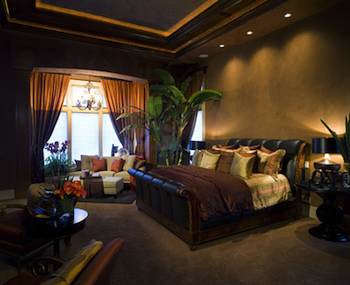By Kathryn Weber

A bedroom designed for sleeping focuses on comfort, soft lighting and deep neutral paint tones to set the stage for relaxation.
A good night's sleep has been shown to be good for health and well-being and to offer many other benefits besides. For example, according to the
Findings like this will come as no surprise to anybody who is chronically sleep-deprived. The question is: what can we do to sleep better? One important first step is to treat your bedroom as an environment for sleep, and decorate it accordingly.
Color and lighting set the tone
Think of a favorite spa, with its low lighting and cocoon-type feeling. That's what you want to recreate in a bedroom designed to promote rest and deep sleep. Start with soft, deep colors. Select dark tones of neutral shades, because neutral tones are calming without being overwhelming the way blue, green or red shades can.
A bedroom designed for deep rest and refreshing sleep makes good use of lighting, too. There should be plenty of light for tasks, but sleep is enhanced by light-dimming window shades or drapes with blackout lining. Adding dark lampshades on bedside lamps helps to soften harsh lighting. Use dimmer switches for overhead lighting.
Focus on comfort
Good design cues for comfort should center on the bed. Choose a headboard that's supportive and comfortable. One that's padded makes a comfy option for sitting up in bed to read before drifting off.
Another critical consideration is the mattress. Take care to select the one you find the most comfortable and enjoyable -- don't choose one because you think it's good for you or because it's a bargain. This is the place you'll spend a third of your life, so comfort and deep relaxation for restful sleep is the goal.
If you're frequently hot at night, buy percale sheets. If you're usually cold, go for a softer sheet such as jersey. Don't forget to buy quality pillows with the type of fill you prefer, such as foam or feather. Be sure to think about texture too when you're working on creating your relaxing bedroom. Buy comforters or duvets in cozy, caressing fabrics, and choose bed throws that are soft and sensual.
Keep it cool, calm and quiet
Keeping the bedroom on the cool side helps promote better sleep. Having solar screen shades or plantation shutters will help to keep the room darkened and thus cooler. You may also want to add a fan or room air conditioner.
A restful room needs to be quiet and relaxing. One of the side benefits of shutters and room-darkening shades or drapes is their ability to dampen noise. Small annoyances, such as a clicking ceiling fan or dripping faucet, can interrupt sleep and should be corrected.
Computers and TVs should be banished from the bedroom. This is something feng shui practitioners and the
By decorating with sleep in mind, your health and ability to keep pace with the demands of living during the day should improve. And who knows? You might even notice improvements in your weight and romantic life, too.
© Living Space by Kathryn Weber
AUTOS | HOBBIES | EDUCATION | FAMILY | FASHION | FOOD & RECIPES | HOME DECOR | RELATIONSHIPS | PARENTING | PETS | TRAVEL | WOMEN
Home & Garden - Better Sleep Begins with Good Bedroom Design